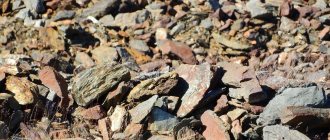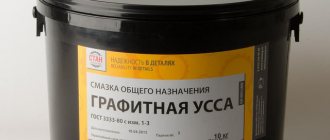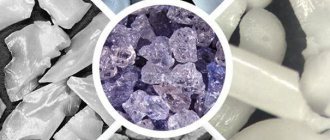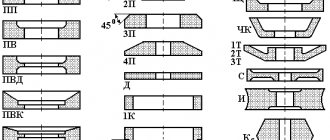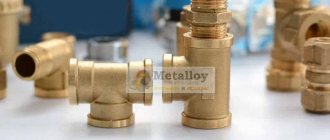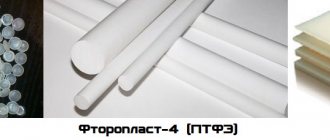One of the most effective methods for increasing the operating efficiency of any equipment without significant investment is the use of innovative lubricants for its maintenance. This trend is especially typical for units operating in difficult conditions - under increased loads, temperatures, friction, etc.
Recently, various products that have received the unofficial general name “copper grease” have become very popular among such materials.
What is copper grease?
Copper grease is usually called a composition with the addition of fine particles of copper powder. These compositions are greases or pastes, both in regular packaging and in spray form.
Thus, the pastes contain base oil, thickener, copper powder, and various additives.
In pastes, compared to greases, the concentration of copper particles is much higher and can reach 60% of the volume. The presence of this type of solid lubricant gives the lubricant a number of properties and the ability to work in conditions that traditional lubricants cannot cope with.
Kinds
Copper greases are sold in different forms:
- There are liquid lubricants in spray form . Using an aerosol, you can lubricate hard-to-reach places in various mechanisms, including automobile ones. Such lubricants will do an excellent job of preserving threaded connections and preventing sticking. For large loaded mechanisms, a spray is not the best option.
- In most cases, copper grease is sold in a consistent (plastic) form . This lubricant is universal and suitable for working with any parts where its use is advisable.
- Copper grease is also available in the form of a solid paste . This lubricant is used in structures that are often exposed to water and air.
Different manufacturers may add some additives to the standard composition of copper grease in order to give it new properties. For example: increase threshold temperatures, reduce the influence of the external environment on work, etc. Manufacturers can also divide the lubricant into copper fractions - there are lubricants with coarse copper particles and lubricants with refined particles. This has a significant impact on the operation of some components and mechanisms.
What type of copper grease do you use?
In liquidIn plastic
Benefits of Copper Grease
Copper in lubricants provides a number of advantages, including the following.
- Wide range of applications for lubricants containing copper
- Efficiency in highly loaded nodes
- Increased heat resistance
- High adhesion to metal surfaces
- Good hydrophobic properties
- Reduced friction coefficient
- Protection against corrosion even in aggressive chemically active environments
- Facilitation of installation and dismantling of equipment components
- Protection against sticking, prevention of welding and seizing of rubbing surfaces
- Wear protection
- Reducing noise and vibration
- Increasing the duration of service intervals when servicing equipment
- Increasing the reliability and service life of threaded connections
- Ensuring uniform tightening forces of threaded connections
- Electrical conductive properties allow the use of copper-containing compounds in electrical and power equipment
Application of copper lubricants
The scope of application of copper lubricants is unusually wide. They are used in production and at home. This type of product is especially popular among motorists and car service organizations.
Copper-based pastes are capable of operating in aggressive environments at extremely high temperatures, reaching up to +1400 °C.
The peculiarity of such materials is that when heated to a certain temperature they exhibit the properties of traditional lubricants. As the temperature rises further, the base oils burn out or evaporate, and the remaining copper powder particles begin to act as solid lubricants.
Due to their heat resistance, copper pastes are widely used for a wide variety of threaded connections, studs, screws, bearings, electrical terminals, pipe fittings, flange pins and other components exposed to high temperatures.
When assembling manifolds, turbine assemblies and other heated surfaces, plant service departments use a lubrication operation, which often requires copper grease.
Copper-based materials are gaining recognition among car service and maintenance companies as lubricants for threaded connections - during repairs, their dismantling takes up to 60% of the total time, according to statistics. Application of pastes to the surface of the thread in advance allows you to prevent sticking and ensure easy installation and dismantling of bolts, studs, nuts without destruction or damage to the threads.
During active driving, the temperature in the brake system mechanisms can reach quite high values. Under these conditions, conventional lubricants dry out, coke and can, over time, lead to disruption of the mobility and smooth running of parts. Heat-resistant copper paste is used to lubricate the calipers and prevent dangerous brake locking.
Anyone who has ever tried to unscrew an injector or glow plugs on diesel engines knows how difficult it is to do this even after a short period of using the car. Copper grease applied to their threaded part before installing these units will allow for easy dismantling even after 100,000 km.
Experience in operating vehicles around the world has shown that copper lubricants have proven to be extremely effective as anti-squeak materials.
They are also used when performing service work in auto centers for processing hub bolts and flanges of axle shafts with drum brakes.
Classification
Based on their composition and areas of application, high-temperature lubricants can be divided into the following:
Silicone based lubricants. Made from synthetic oils thickened with silica gel. They have relatively low temperature indicators - on average, from 180 to 250ºC.
Ideal for plastic friction units, used in sewing machines, fans, household ovens, and office equipment. Also used for sealing units in water supply systems.
The main advantage of silicone lubricants is the creation of a durable moisture-proof layer on surfaces. In addition, they are insensitive to sudden temperature changes.
Lithium-based lubricants. They are mainly used for automobile or motorcycle bearings and have a high viscosity class. Previously, liquid lubricants were used in this area, but they had a short service life, and the bearings required more frequent maintenance.
The duration of action of modern lithium greases is much longer. In addition to lubricating properties, they have extreme pressure properties, thanks to appropriate additives, and also protect bearings from dust and other small particles.
Lithium compounds also have good conductive characteristics, which allows them to be used in the production of electric motors and for protecting electrical contacts at high temperatures. Lithium greases retain their performance up to 250ºC, and some brands – up to 350ºC.
Graphite lubricants. The base is synthetic or organic oils with the addition of a large amount of crushed graphite. They look like a thick black ointment.
They are used in hot shops, for example, in the production of bakery products. In addition, they are in demand in brick factories, as well as in equipment for oil and gas production.
Well suited for water supply fittings in high temperature conditions - in boiler rooms and hot water distribution stations. The temperature indicators of this type of lubricant are high – up to 400ºC. It should be noted that at 250ºC the oil base of the lubricant begins to burn out, leaving only graphite, which provides protection and lubrication of the working surfaces. As the oil burns out, smoke may be released, so such lubricants can only be used in rooms with good ventilation.
Copper lubricants. They are produced on the basis of copper from mineral, synthetic, and semi-synthetic oils. They are used to protect threaded connections, in low-speed friction units operating at high temperatures, and to lubricate press molds in foundries.
Used in the automotive industry. They have good water-repellent properties and do not change their properties when interacting with various types of metals. Protect surfaces from scuffing and aggressive environments. Due to the presence of copper particles in the composition, they have high electrical conductivity. Tolerates temperatures up to 1100ºC.
Ceramic lubricants.
Main advantages:
- resistant to water and other wet environments;
- do not change their composition and properties when interacting with alkalis, acids and other aggressive substances;
- do not affect rubber and plastic, protect against corrosion and lubricate.
They have good dielectric properties. Boron nitride is most often used as a ceramic component, the lubricating characteristics of which in some compositions are better than that of molybdenum disulfide.
Boron nitride is a white powder; lubricants based on it are, accordingly, white. The crystal lattice of boron nitride is similar in structure to diamond.
Ceramic lubricants are used in car maintenance, in particular, for processing threaded connections exposed to high temperatures - spark plug sockets, as well as brake pad bolts. After this treatment, the thread does not corrode and does not “sour”, which ensures easy unscrewing. Ceramic lubricants are also used in the oil refining and steel rolling industries. The temperature resistance of ceramic compositions is very high and reaches 1500ºC for some brands.
Despite their specificity, high-temperature lubricants have diverse qualities and are used in a wide variety of areas. Almost all manufacturers of various oils, among the entire variety of assortments, always have a line of high-temperature lubricants.
Application Features
Before applying copper paste, the surface of a threaded joint, bearing or other assembly should be thoroughly cleaned of any remaining old lubricants, dust and dirt. The material is applied to the surface in small quantities using a brush (preferably made of synthetic materials), a swab, or a syringe. Excess grease can be removed with a rag.
The treatment of rolling bearings with copper grease has one peculiarity. A large amount of copper paste in this unit is unacceptable and can lead to its failure or a sharp decrease in the level of operational properties. Lubricant should be applied to the raceways in a thin layer. After this, we recommend running-in - turning the lubricated bearing several times in both directions and removing excess grease.
Instructions for use
Instructions for using this product differ depending on its form.
Thus, LIQUI MOLY Kupfer-Paste is applied with a brush, brush or soft cloth directly to the parts. The aerosol is sprayed, which makes it more convenient for hard-to-reach places. The general rule for application is that the lubricant should only be used on thoroughly cleaned surfaces. They must be freed from traces of previous lubrication, corrosion, oxidation and other contaminants. Only in this case the product will be effective.
To clean the sprayer after use, take the spray upside down and press several times until the head is cleaned.
How to lubricate the threads?
Threaded connections made from conventional steels are often subject to corrosion. Formed on the thread turns, it tightly holds the parts together. When trying to dismantle them, great difficulties arise, even to the point of destruction of parts or the need to use special tools.
Copper grease has excellent protective functions and is one of the most effective means of preventing corrosion and makes it easy to disassemble connections even after many years of use.
Of course, this material is more expensive than, say, conventional graphite-based materials, but it can operate in much more difficult conditions. Under high-temperature operating conditions, copper grease has no competitors.
Reviews
“Copper grease is an indispensable product. I use it almost everywhere. I can say that copper grease makes the life of any person much easier. For example, I apply it to the hubs before installing winter or summer wheels. After this, I don’t have any problems during dismantling, like other motorists. I can say that I don’t have any problems after using the lubricant.”
“If you want to purchase a universal lubricant, then pay attention to copper. I process various threads and connections with it. In addition, I can apply it to metal parts to prevent corrosion.”
Copper grease is a fairly common compound in the automotive industry. It is often used at the factory during the car assembly process, as well as in service centers during repairs. Copper grease, as the name suggests, is made from copper, which has high thermal resistance, which allows it to protect threaded connections from welding, wear, seizing and other defects. Copper grease is also used in other automotive components.
Read also: How to test a power transistor with a multimeter
Copper lubrication and tire work
Surely some car owners have encountered problems with discs sticking to wheel hubs. Applying copper grease to the surface of the hub will make it easier to remove the discs during tire fitting. Some are skeptical about this use.
Of course, with regular maintenance and careful treatment of the car, sticking of the discs usually does not occur, but if the car is operated for a long time in difficult off-road conditions, dust, water, dirt, then it is quite possible that copper lubricant will provide you with an invaluable service.
And even more so, applying lubricant to the surface of the hub will protect it from corrosion.
Wheel nuts and bolts with copper-containing lubricant applied during installation will also not present you with unpleasant surprises in the future.
How to apply it correctly?
Of course, choosing a good copper grease is not an easy task. However, in order for it to bring positive results when used, it must be applied correctly. Only in this case will the material protect the surface for a long time. When applying it is very important to observe the following rules:
- Before lubricating the work surface, it must be thoroughly treated. To do this, clean it of dirt, residual dirt, moisture, and chemical components.
- To apply copper grease, you must use a brush or piece of cloth - it is strictly forbidden to do this with clean hands.
- Excess penetrates through the capillary holes. Therefore, it is not necessary to delete them at all.
- If copper grease is applied to bearings, they must be thoroughly worked before fastening. To do this, rotate them several times in each direction.
Caliper Lubricant
Brake calipers work in difficult conditions. This, combined with the design feature, leads to creaking, accelerated wear of the pads, and heating. These processes occur uncontrolled, on different supports with varying degrees of intensity. As a result, the braking forces on the wheels are distributed unevenly, which can lead to skidding even with light braking.
These problems are prevented by using special materials. However, traditional lubricants for thrombose calipers are not suitable - they are washed out with water, burn out or coke, which only aggravates the situation and leads to even greater wear of brake parts.
Copper lubricants (pastes) have become a successful solution for lubricating anti-squeak plates, guide pins, back and end surfaces of pads. They effectively dampen vibrations and provide excellent lubrication of surfaces with small reciprocating movements under aggressive environmental conditions.
It should be remembered that many copper pastes are made with mineral oils, which can cause destruction or swelling of rubber elements. Contact of such pastes with rubber caps, cuffs, and anthers installed in brake mechanisms must be excluded.
The use of a pneumatic impact wrench when tightening parts is prohibited.
Two-thirds of mechanics tighten wheel bolts with an air impact wrench - this is a mistake. Even if after this the mechanic picks up a torque wrench, it is already useless, the bolts are guaranteed to be overtightened. The metal of the wheel rim at the point of contact with the bolt is excessively crushed, the threaded part of the bolt or stud is pulled out, and microcracks appear in the metal. The result is loose pressure on the wheel rim, runout, and wheel separation.
The technical documentation of each automaker indicates the tightening torque of the wheel fasteners, and the task of each mechanic is simply to use this information correctly. The wheel fasteners are tightened using a mechanical tool until the fastener touches the wheel rim, followed by the use of a torque wrench.
How to choose copper grease?
The selection should be made based on your needs. It is important to understand at what temperatures will copper paste work? Will you put it in a rotating assembly or in a static threaded connection, such as spark plugs (in the first case, the viscosity of the base oil is important to you, in the second case it is not so critical). How high are the temperatures in your friction unit (the temperature of the medium and the bearing are not the same).
Pay attention to whether the composition contains a corrosion inhibitor - this will both extend the service life of the lubricant itself and protect your unit from corrosion, and since many packages of modern additives, in addition to anti-corrosion resistance, also improve tribological characteristics, this will most likely increase the load capacity of the paste.
The use of copper lubricants and pastes for servicing industrial equipment or vehicles makes it possible to solve many problems at minimal cost that conventional lubricants cannot do. High heat resistance and load-bearing capacity are the main advantages that make it possible to effectively use copper-containing materials in a wide variety of industries and find many applications for them.
Properties and characteristics
Considering the possibility of using high-quality automotive copper lubricant for pads and other components of the brake system, it will not be superfluous to keep it on hand when turning drums or as part of checking brake disc wear.
Important properties of the composition are its good electrical conductivity and the ability to reduce friction forces. The lubricant is well protected from moisture, does not wash out, and does not evaporate during operation.
IMPORTANT! Copper lubricants do not contain lead. This allows the product to be used when processing threaded connections.
